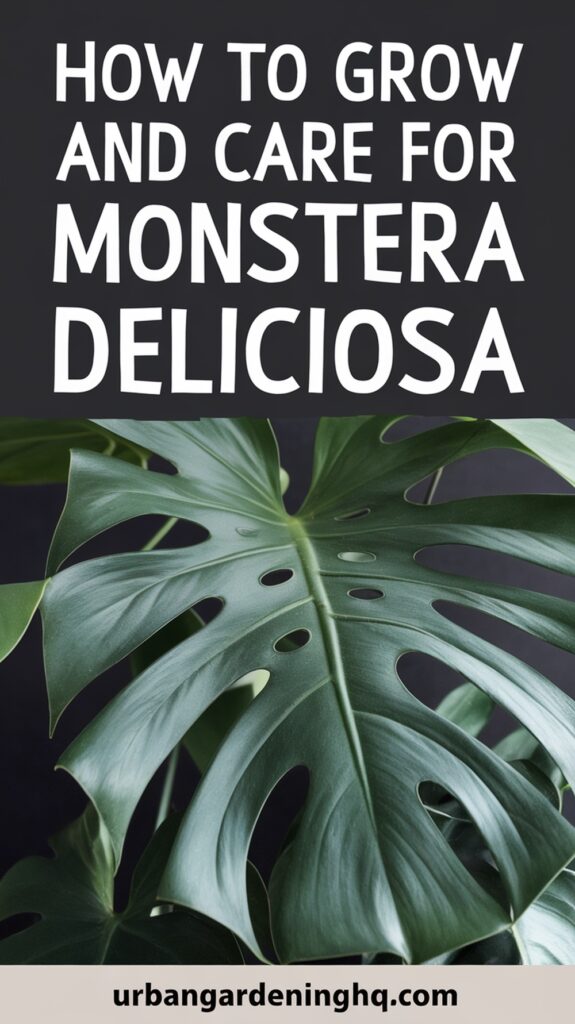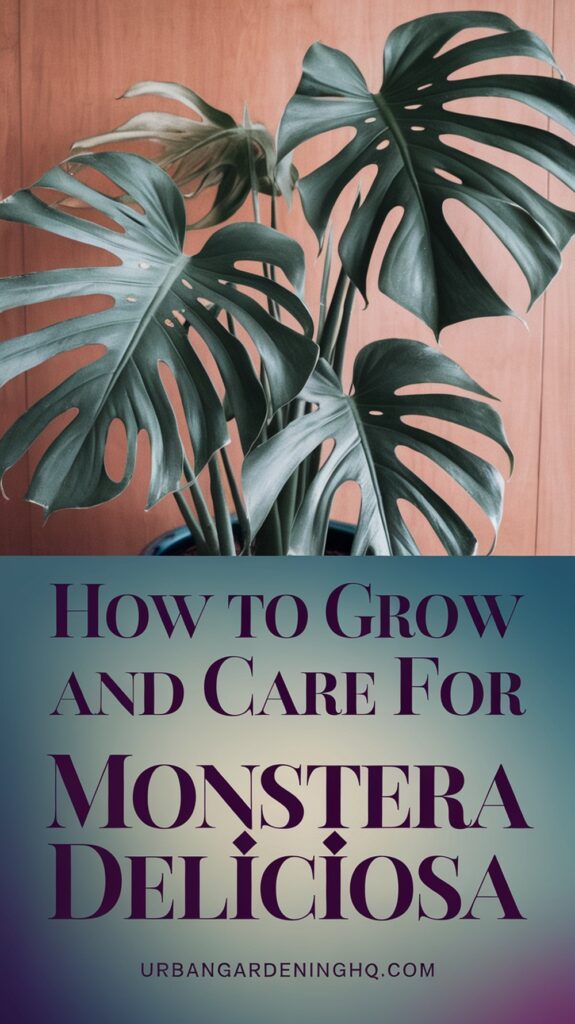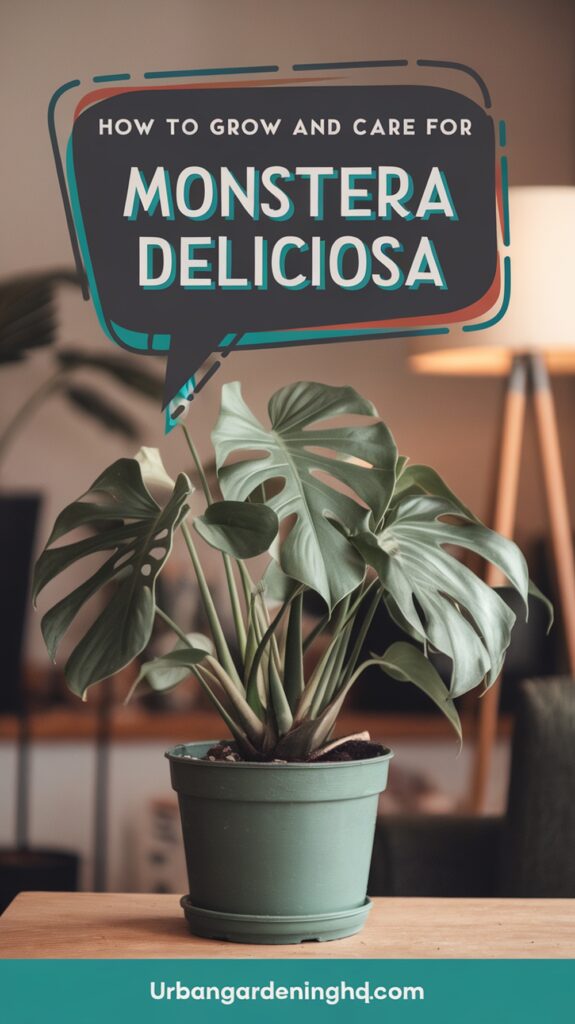I’m excited to share my journey of learning how to care for my Monstera Deliciosa. This houseplant is known for its unique, holey leaves. It can grow well in different lighting conditions, making it great for indoor plants.
As a beginner, I want to learn how to care for my Monstera Deliciosa. I want it to thrive in my home and become a stunning addition. It will bring tropical beauty and freshness to my space with the right indoor plants.
Understanding Your Monstera Deliciosa

To truly appreciate your Monstera Deliciosa, it’s key to know its natural home and how it grows. This plant comes from the tropical areas of Central and South America. It climbs up trees using its aerial roots to get moisture and nutrients from the air.
In the wild, Monstera Deliciosa grows as an epiphyte. This means it can live in low-light places. It’s perfect for indoor spaces because of this. Knowing its natural home helps you create the right conditions for it in your home.
Natural Habitat and Growth Patterns
Monstera Deliciosa can grow in many conditions. Its natural home has:
- Tropical climates with high humidity
- Low-light conditions, often found in the understory of rainforests
- Aerial roots that absorb moisture and nutrients from the air
Why Monsteras Make Perfect Indoor Plants
Monsteras are great for indoor spaces. They’re easy to care for and can handle different light levels. They can grow well in both low and bright indirect light.
Common Varieties and Their Characteristics
There are many Monstera Deliciosa varieties, each with its own look. The ‘Albo-Variegata’ and ‘Thai Constellation’ are popular for their white or yellow patterns. Knowing about these varieties helps you pick the right one for your home. You can then give it the care it needs to thrive.
Essential Light Requirements for Healthy Growth

Exploring Monstera Deliciosa care, I’m curious about the light needs for my plant. The right light is key for my Monstera to grow well. It can handle low light but does best in bright, indirect light. I can use sheer curtains or grow lights to get this right.
Monstera Deliciosa can grow in various light levels, from low to bright indirect. Knowing its specific light needs is vital. This ensures my plant grows strong and looks great. For more tips, I can check out Urban Gardening HQ.
To give my Monstera the right light, here’s what to do:
- Put the plant near an east- or west-facing window for bright, indirect light.
- Use sheer curtains to filter the light and prevent scorching.
- Consider using grow lights to supplement the natural light, specially in winter.
Watering Your Monstera: Finding the Perfect Balance
To keep my Monstera Deliciosa happy, I need to find the right watering balance. Too much water can cause root rot, while too little can dry out the leaves. I check the soil moisture by sticking my finger into it up to the first knuckle. If the top inch feels dry, it’s time to water.
Creating a good watering schedule is key to keeping the soil moist. I water my Monstera Deliciosa when the top inch of soil is dry. This usually happens once a week in summer and less in winter. Here are some tips for your own watering schedule:
- Check the soil moisture often, more so in hot and dry weather
- Water your Monstera Deliciosa in the morning for better absorption
- Use a well-draining potting mix to avoid waterlogged soil
By following these tips and adjusting my watering schedule, I keep my Monstera Deliciosa healthy. A good watering schedule prevents both overwatering and underwatering. This keeps my plant strong and healthy.
Soil and Potting Requirements
Understanding the soil needs is key for a healthy Monstera Deliciosa. The right mix can greatly impact your plant’s health and growth. I’ve found that a mix that drains well and is rich in organic matter works best for my Monstera Deliciosa.
For the perfect soil, look for a mix with peat moss, perlite, and vermiculite. This mix offers great drainage, aeration, and water retention. It meets your Monstera Deliciosa’s specific soil needs. Here are the key features of a good potting mix:
- High organic matter content for nutrient retention
- Good drainage to prevent waterlogged soil
- Aeration to promote healthy root growth
Choosing a mix that meets these criteria will help your Monstera Deliciosa thrive. Remember, every plant is different. Take the time to find out what’s best for your Monstera Deliciosa.
| Potting Mix Component | Benefits |
|---|---|
| Peat Moss | Retains moisture, suppresses weeds |
| Perlite | Improves drainage, prevents waterlogging |
| Vermiculite | Enhances aeration, promotes healthy root growth |
Temperature and Humidity Needs
To create the perfect home for my Monstera Deliciosa, I must focus on the right temperature and humidity. This tropical plant loves warm spots, between 65-75°F (18-24°C). It also needs humidity above 50% to thrive.
Keeping humidity levels right can be done in several ways. I can use humidifiers or group plants together. This helps maintain the ideal humidity for my Monstera Deliciosa, even in dry places. Here are some tips:
- Use a humidifier to keep humidity above 50%
- Group plants together to create a microclimate
- Place the plant on a tray filled with water and pebbles to increase the surrounding humidity
Knowing the best temperature and humidity for my Monstera Deliciosa helps me care for it better. With the right conditions, it will grow well and look amazing. I can then enjoy its beauty as a stunning houseplant.
Fertilizing Your Monstera Deliciosa

Fertilizing my Monstera Deliciosa is key for its health. During the growing season, it needs regular food to grow well. This helps keep the soil rich with nutrients.
Choosing the right fertilizer is important. I look at balanced options that have nitrogen, phosphorus, and potassium in equal parts. I always dilute it as directed to protect the roots. For more tips, I check out urban gardening guides.
Here are some tips for fertilizing my Monstera Deliciosa:
- Use a balanced fertilizer that meets the plant’s needs.
- Dilute the fertilizer to avoid harming the roots.
- Fertilize during the growing season for best results.
Pruning and Maintenance Tips
Regular pruning is key to keeping my Monstera Deliciosa healthy and looking good. It helps control the plant’s size and encourages new leaves to grow. This makes the plant look better and prevents it from getting too big.
Knowing when and how to prune is important for plant care. I prune my Monstera in the spring and summer when it’s growing fast. This helps it grow well and get new leaves. For more tips on pruning, check out mycityplants.com.
Pruning Techniques for Healthy Growth
- Use sharp, clean pruners to prevent spreading diseases and to make precise cuts
- Remove any dead or damaged leaves or stems to prevent the spread of disease and encourage healthy growth
- Prune back long vines or stems to control the size of the plant and promote bushy growth
By using these pruning techniques, my Monstera Deliciosa stays healthy and looks great. Regular pruning and care help it thrive. I’m sure it will keep being a beautiful part of my home.
Common Problems and Solutions
As a Monstera Deliciosa owner, I’ve faced many common issues. Pests, diseases, and nutrient deficiencies can happen even with good care. It’s key to spot the problem early and act fast to stop it from getting worse.
Some common problems with Monstera Deliciosa include:
- Pests: mealybugs, spider mites, and scale
- Diseases: root rot, leaf spot, and powdery mildew
- Nutrient deficiencies: lack of nitrogen, iron, or magnesium
To tackle these issues, regular checks and care are vital. Look for pests or diseases on your plant. Adjust your watering and fertilizing as needed. Also, make sure your plant gets the right light and humidity.
By staying alert and acting quickly, you can avoid big problems. This way, your Monstera Deliciosa will stay healthy and vibrant.
Propagation Methods and Techniques
I’ve grown fond of my Monstera Deliciosa and want to share it with loved ones. Propagation is a fun way to do this. It lets me create new plants to give away or add to my collection. Propagation needs some knowledge but is a rewarding hobby.
There are several ways to propagate, like node cutting, water, and soil methods. Each has its own benefits and needs. The right choice depends on what you want and what you have. For roots to grow well, they need the right light, water, and food.
Node Cutting Propagation
Node cutting is simple. Cut a stem section above a node and plant it in soil or water. Use a rooting hormone and keep the soil or water moist for best results.
Water vs Soil Propagation
Water and soil are two common ways to root cuttings. Water propagation uses a glass of water, while soil planting goes straight into soil. Your choice depends on what you like and the plant’s needs.
Tips for Successful Root Development
For roots to grow well, provide the right conditions. This means:
- Adequate light: Plants need bright, indirect light to grow.
- Consistent moisture: Soil or water should be moist but not too wet.
- Nutrients: A balanced fertilizer helps with healthy growth.
By following these tips and picking the right method, I can share my Monstera Deliciosa. Plant propagation is rewarding and lets me grow my collection and connect with others.
Supporting Your Monstera’s Growth
Watching my Monstera Deliciosa grow shows me how vital support is. This climbing plant needs a support to climb and keep its shape. Support structures help it reach its best.
Choosing the right support for my Monstera depends on its size and growth. Trellises, moss poles, and arbors are good options. They let my Monstera climb and add beauty to my space.
Types of Support Structures
- Trellises: These are great for providing a wide surface area for my Monstera to climb.
- Moss poles: These are ideal for smaller plants or for creating a more compact climbing structure.
- Arbors: These provide a more dramatic support structure, perfect for larger plants or for creating a statement piece in my garden.
To train my plant, I gently twine its stems around the support. As it grows, it will cling to the support with aerial roots. With patience, my Monstera will grow tall and beautiful, adding to my indoor space.
Conclusion: Growing Your Monstera Success Story
As we reach the end of this guide, I hope you’re ready and excited to start your Monstera Deliciosa journey. With the right care, this iconic houseplant can add beauty to your home. It brings a touch of tropical elegance wherever it grows.
Remember, patience and observation are key for successful growth. Every Monstera is unique and thrives best with a personalized approach.
By following the tips in this article, you now have the knowledge to grow a thriving Monstera Deliciosa. It will bring you joy for years. Whether you’re a seasoned plant parent or a beginner, I encourage you to enjoy the journey. Celebrate your Monstera’s progress along the way.
So, go ahead, get your hands dirty, and watch your Monstera Deliciosa grow. I’m excited to hear about your success stories and the beautiful memories you’ll make with this remarkable plant. Happy growing!


